Every fleet manager strives to build supply chain resiliency. Often, those who fall short are simply lacking the tools required to thrive in this industry. Every good fleet manager is aware of the importance of a telematics system and has implemented them into their logistics operations. However, the best fleet managers have gone above and beyond telematics, integrating those systems with fleet tracking solutions. This blog explains the importance of building supply chain resilience and how a fleet tracking system can make it possible.
Increase Your ROI by Investing in AirFinder Everywhere
- Loss Prevention. Reduce the amount of loss that occurs during the supply chain process
- Location Coverage. AirFinder Everywhere uses a combination of GPS, Cellular, and WiFi to determine location everywhere
- Security Alerts. Know when a delay in shipment has occurred so the problem
can be addressed immediately.
Why You Should Strive for Supply Chain Resilience
1. Prepare for Unplanned Disruptions
Companies should always anticipate problems by taking steps to avoid them. Recognize common areas leading to supply chain struggles and change operations to account for them. Even so, not every problem can be avoided. These problems are typically caused by outside parties. This doesn’t mean you should sit back and wait for these things to happen. Instead, you need a plan for how to address the problem once it occurs. For example, you can plan your route times around rush hour traffic and adjust routes around construction zones. What you can’t plan for is an accident on the highway leading to long delays, but you can create a plan for how to address the situation in the case it happens. Planning for as much as you can helps improve customer service and reduces the loss suffered in these situations. If you plan for the unexpected, you’re strengthening your supply chain and taking the steps toward success.
2. Minimize Financial Losses
The disruptions mentioned above can lead to financial losses. Avoiding loss increases profit margins and allows for expansions. Taking a proactive approach allows fleet managers to identify any potential vulnerabilities so they can implement contingency plans ensuring smooth responses to disruptions. This helps reduce the likelihood of incurring significant financial losses. An area that causes large financial losses is supply chain shortages. Having visibility into every supply chain stage, allows for early supply chain shortage detection and timely interventions.
3. Seize Competitive Advantages
The more resilient your supply chain, the more you stand apart from your competitors. When you are equipped with the tools to address supply chain challenges that your competition cannot, consumers are more likely to go through you for their needs instead of them. With the ever changing market, you need the tools to quickly adapt to industry and regulation changes. When changes in the industry happen or a domino effect of issues occur, unprepared companies are caught off guard and have to play catch up. In extreme cases, they have to temporarily pause operations, leading them to fall further behind. By maintaining usual operations during a time of crisis, you’ll further stand out from the competition.
4. Enable Informed Decisions
The best decisions are made based on data. The more information you have before making a decision, the less risk there is involved in the decision. When equipped with proper analytics, fleet managers can quickly assess the impact of disruptions and devise effective strategies. Additionally, data helps fleet managers identify areas of inefficiency so they can make adjustments to improve productivity and efficiency.
Why Are Fleet Tracking Systems Important?
When fleet tracking software is integrated into telematics, fleet managers gain full visibility into their supply chain operations. The telematics system provides insight into truck activities and driver behavior. A fleet tracking system gives insight into non-powered assets including the trailer and everything on the trailer. Integrating this system into your telematics system means you can see all the data you need in one location to make decisions and optimize operations. Let’s walk through each way fleet tracking builds supply chain resilience.
Trailer Tracking
There are two main reasons tracking your trailers is beneficial. The first one is for usage optimization. Many fleet managers are unaware that they have trailers being underutilized. This leads to a few issues. The trailers in use become overutilized, thus shortening their lifespan. Underutilized trailers also mean that your company isn’t operating as efficiently as possible. A fleet tracking system tells companies how often their trailers are being used by tracking their location at all times. When fleet managers pull their reports, they can see which trailers have moved and which haven’t. From there, usage adjustments can be made to ensure every trailer is being used efficiently.
The second reason trailer tracking is important comes from tracking them on the road. Whether you’re looking to optimize routes or stay up to date on traffic patterns, you need visibility of your trailers’ movements. While some traffic can be predicted during rush hour or along routes with construction, you can’t anticipate an accident holding up traffic on the highway. Delays cannot be avoided with these situations and lead to delayed shipment arrivals. Delayed shipments lead to unhappy customers and lost business. Instead of running this risk. You can track your trailers in real time and be alerted of unplanned delays. When a delay occurs, you are notified and can then alert the customer of the adjusted delivery date. They may be disappointed by the late arrival, but will likely appreciate the transparency you provide.
Theft is another occurrence companies want to avoid. Trailers cost a lot of money and thieves are aware of the high return they would get from stealing them. When there is a tag on the trailer, it will be tracked the entire time so it can be retrieved easily. Additionally, a GPS fleet tracking system has geofencing capabilities that come in handy during these times. All fleet managers have to do is set up geofences surrounding their facility. When tags cross the virtual boundary, an alert is sent of the movement. If a trailer has crossed a boundary when it shouldn’t have, the fleet manager can take action to retrieve it before it’s too far gone.
Pallet Tracking
Just because you have visibility of your trailers, doesn’t mean you automatically have visibility of the pallets and cargo on those trailers. An unfortunate occurrence companies who manage logistics operations have to deal with is theft. There are times when trailers as a whole are stolen - trailer tracking helps to prevent this - but more often, thieves want what’s inside the trailers. So they’ll break in and take the pallets filled with cargo or the cargo itself. Having only a fleet tracking device on the trailer isn’t enough to help in this situation. Putting a tag on the pallets inside the trailer will. If a pallet with a fleet tracking device is removed from the trailer, fleet managers are notified right away which cuts down on reaction time. They also have the ability to track the location of the pallet as it moves with the thieves so the police can easily retrieve the stolen asset.
The same concept can be applied to a similar scenario. With all the moving pieces in supply chain operations, things can easily get overlooked. In the daily rush, a pallet can be loaded onto the wrong truck or left behind at the warehouse. When this happens, the tag on the trailer can alert the fleet manager of the missing pallet so steps can be taken to put the right pallet on the right trailer instead of not knowing until a customer calls to complain. At that point, the package may have been discarded due to the confusion. Even if it wasn’t, it will still take more time to arrive at its intended destination. Avoiding these situations helps to improve customer service and is the best way to prepare for the unexpected and unwanted situations.
Cold Chain Monitoring
The cold chain industry has many compliance regulations in place that must be followed, specifically surrounding temperature. These requirements were put in place to ensure the safety of these sensitive items throughout the stages of the supply chain. Without these laws being followed, consumers can get sick. Following these regulations is the only way to ensure safety, but it’s not always easy. Reefer trailers can fail, leading to changing temperatures inside the trailer. Additionally, if a trailer is incorrectly loaded, the temperature of the truck may say it’s at the right temperature but the boxes on the bottom may not be exposed to the temperature, leading to spoilage. With fleet tracking, you can know the temperature of all units of cargo at all times. The tags have embedded sensors that monitor the temperature at all times. Fleet managers simply have to define the safe temperature zone. If the temperature falls above or below the safe threshold, they will be notified so the driver can stop to address the problem before spoilage occurs.
Is Your Supply Chain Resilient?
When you’re taking steps to make your supply chain resilient, you’ll not just survive the unexpected challenges you face; you’ll thrive. One of the best ways you can build supply chain resilience is by investing in a fleet tracking system. Our solution, AirFinder Everywhere, was built to help fleet managers take control of their supply chain operations. The visibility and data it provides allows your supply chain to operate as efficiently as possible. To learn more about this solution and how you can use it to build supply chain resilience, book a demo with our team of experts.





